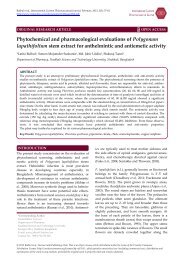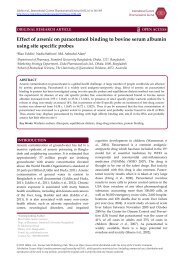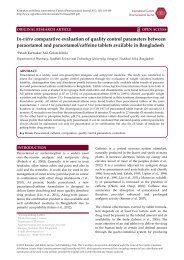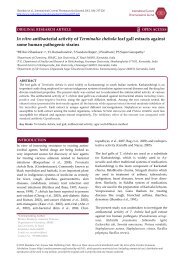Rutin- potent natural thrombolytic agent - International Current ...
Rutin- potent natural thrombolytic agent - International Current ...
Rutin- potent natural thrombolytic agent - International Current ...
Create successful ePaper yourself
Turn your PDF publications into a flip-book with our unique Google optimized e-Paper software.
Dar and Tabassum, <strong>International</strong> <strong>Current</strong> Pharmaceutical Journal 2012, 1(12): 431-435<br />
http://www.icpjonline.com/documents/Vol1Issue12/07.pdf<br />
<strong>Rutin</strong>- <strong>potent</strong> <strong>natural</strong> <strong>thrombolytic</strong> <strong>agent</strong><br />
Mohammad Arif Dar, *Nahida Tabassum<br />
Department of Pharmaceutical Sciences, Pharmacology Division, University of Kashmir, Srinagar-190006, J&K, India<br />
INTRODUCTION<br />
Thrombosis is the process of formation of solid mass<br />
or thrombus in circulation from the constituents of<br />
flowing blood. A blood clot is the mass of coagulated<br />
blood formed in vitro e.g. in a test tube. The<br />
extra-vascular accumulation of blood clot e.g. into<br />
the tissues is known as Haematoma while the blood<br />
clots formed in healthy individuals at the site of<br />
bleeding e.g. in injury to the blood vessel are called<br />
Haemostatic plugs. In other words, haemostatic<br />
plug at the cut end of a blood vessel may be considered<br />
the simplest form of thrombosis. Haemostatic<br />
plugs are useful as they stop the escape of blood and<br />
plasma, whereas thrombi developing in the unruptured<br />
cardiovascular system may be life threatening<br />
by causing ischaemic injury and Thromboembolism<br />
(Mohan, 2006).<br />
Thrombosis or blood clot formation and its consequences<br />
remain a leading cause of morbidity and<br />
mortality, and recurrent thrombosis is common<br />
<strong>International</strong> <strong>Current</strong><br />
Pharmaceutical Journal<br />
REVIEW ARTICLE OPEN ACCESS<br />
ABSTRACT<br />
Thrombosis, the formation of blood clots, is a cause not only of heart attacks and strokes, but of deep venous thrombosis<br />
(DVT) and pulmonary embolism as well. The number one killer of Americans is a blood clot that blocks blood<br />
flow to the heart or to the brain and approximately half of all morbidity and mortality in the United States can be<br />
attributed to heart attack or stroke. All the blood clot related conditions are life-threatening, and so there is a need for<br />
safe, effective and preventive treatment. A <strong>natural</strong> substance rutin, also called rutoside, is a citrus flavonoid glycoside<br />
found in Fagopyrum esculentum (buckwheat), the leaves and petioles of Rheum species, and Asparagus. This flavonoid<br />
compound has shown effective <strong>thrombolytic</strong> activity (prevents the formation of blood clots) by blocking the enzyme<br />
protein disulfide isomerase (PDI) found in all cells involved in blood clotting. Food and Drug Administration (FDA)<br />
has established that rutin is safe and, thus provides a safe and inexpensive drug that could reduce recurrent clots and<br />
help save thousands of lives.<br />
Key Words: Fibrinolytics, rutoside, flavonoid, protein disulfide isomerase, clotting, Fagopyrum esculentum.<br />
*Corresponding Author:<br />
Dr. Nahida Tabassum, Associate Professor<br />
Department of Pharmaceutical Sciences<br />
University of Kashmir, Hazratbal, Srinagar,<br />
J&K-190006, India<br />
E-mail: n.tabassum.uk@gmail.com<br />
Contact No.: 09419906868<br />
despite current optimal therapy (Jasuja et al., 2012).<br />
Clots in arteries are platelet rich where as in veins<br />
they are fibrin rich. <strong>Rutin</strong> presents and treats both<br />
types of clots (Hart, 2012).<br />
Thrombolytic drugs rapidly lyse thrombi by<br />
catalyzing the formation of plasmin from plasminogen.<br />
These drugs create a generalized lytic state<br />
when administered intravenously. Thus, both<br />
protective hemostatic thrombi and target thromboemboli<br />
are broken down (Zehnder, 2009).<br />
Thrombolytics or fibrinolytics can remove established<br />
thrombi and emboli. The removing of the<br />
products of coagulation when they have served<br />
their purposes of stopping a vascular leak is the<br />
function of the fibrinolytic system. This system<br />
depends on the formation of the fibrinolytic enzyme<br />
plasmin from its precursor protein known as<br />
plasminogen in the blood. Plasminogen binds to<br />
specific sites on fibrin during the coagulation<br />
process. Simultaneously, the <strong>natural</strong> activators of<br />
plasminogen i.e. tissue plasminogen activator (tPA)<br />
and urokinase are released from endothelial and<br />
other tissue cells and act on plasminogen to form<br />
plasmin. Since fibrin is the framework of the<br />
thrombus its dissolution clears the clot away<br />
(Bennett and Brown, 2003).<br />
© 2012 Dar and Tabassum; licensee Saki Publishing Club. This is an Open Access article distributed under the terms of the Creative Commons<br />
Attribution License (http://creativecommons.org/licenses/by-nd/3.0/), which permits unrestricted use (including commercial use), distribution and<br />
reproduction of the work in any medium, provided the original work is properly cited and remain unaltered.
MAIN<br />
MAIN<br />
CLASSES<br />
CLASSES<br />
OF<br />
OF<br />
DRUGS<br />
DRUGS<br />
USED<br />
USED<br />
IN<br />
IN<br />
THROMBOSIS<br />
THROMBOSIS<br />
First generation: Streptokinase, Urokinase,<br />
APSAC (Anisoylated plasminogen streptokinase<br />
activator complex), Single chain urokinasetype<br />
plasminogen activator (Scu-PA, Prourokinase).<br />
Second generation: Recombinant tissue plasminogen<br />
activators (rt-PA): Alteplase, Reteplase,<br />
Tenecteplase, Lanoteplase, Monteplase, YM866,<br />
Staphylokinase (recombinant), recombinant single<br />
chain urokinase-type plasminogen activator<br />
(r scu-PA).<br />
Miscellaneous: Nattokinase, <strong>Rutin</strong>.<br />
RUTIN (QUERCETIN-3-RUTINOSIDE)<br />
Source<br />
<strong>Rutin</strong> is a flavonol abundant in a variety of commonly<br />
ingested foods. The name ‘rutin’ came from a<br />
plant known as Ruta graveolens that also contains<br />
rutin. It is found in high concentrations in teas and<br />
fruits (Jasuja et.al, 2012). Buckwheat seeds (Fagopyrum<br />
esculantum) are the richest source (Steal, 2012).<br />
It is also found in the leaves and petioles of Rheum<br />
species and Asparagus, in the fruits and flowers of<br />
the pagoda tree, fruits and fruit rinds mainly of<br />
citrus fruits (like orange, grapes, lemon, lime) and in<br />
ash tree fruits, in berries such as mulberry and<br />
cranberries. It is also found in Clingstone peaches as<br />
one of the primary flavonols. European Elder<br />
(berry), Hawthorn (Crataegus laevigata), Horse tail<br />
(Equisetum arvense), Bilberry (Viccinium myrtilus)<br />
(Pendleton, 2012).<br />
<strong>Rutin</strong> was found to inhibit thrombus formation at<br />
concentrations that are well tolerated in mice and<br />
humans. Inhibition of thrombus formation by rutin<br />
in mice was completely reversed by infusion of<br />
recombinant Protein Disulfide Isomerase (PDI).<br />
Thus, rutin binds to and reversibly inhibits PDI but<br />
shows only minimal activity towards other extracellular<br />
thiol isomerases present in the vasculature.<br />
Evaluation of the effect of flavonol ingestion on<br />
cardio-vascular events demonstrated protection<br />
from myocardial infarction and stroke with increased<br />
intake (Jasuja et al., 2012).<br />
Figure 1: Structure of <strong>Rutin</strong> (Jasuja et al., 2012).<br />
Two flavonoids, rutin and hesperidin, were investigated<br />
in vitro for anticoagulant activity through<br />
coagulation tests: activated partial thromboplastin<br />
time (aPTT), prothrombin time (PT) and thrombin<br />
time (TT). Only an ethanolic solution of rutin at the<br />
concentration of 830μM prolonged aPTT, while TT<br />
and PT were unaffected. <strong>Rutin</strong> could thus also be<br />
used as an anticoagulant (Kuntic et al., 2011).<br />
Chemistry<br />
<strong>Rutin</strong> is the glycoside between the flavonol quercetin<br />
and the disaccharide rutinose (α-L-<br />
Rhamnopyranosyl-(1→6)-β-D-glucopyranose) as<br />
shown in figure 1.<br />
PROTEIN DISULFIDE ISOMERASE (PDI)<br />
Protein disulfide isomerase (PDI) is the prototypical<br />
member of an extended family of oxidoreductases<br />
(endoplasmic reticulum-resident enzymes). These<br />
enzymes catalyze posttranslational disulfide bond<br />
formation and exchange and serve as chaperones<br />
during protein folding (Hatahet et al., 2009). Although<br />
having a C-terminal endoplasmic reticulum retention<br />
sequence, PDI has been identified at many diverse<br />
subcellular locations outside the endoplasmic reticulum.<br />
It has biological functions on the cell surfaces of<br />
lymphocytes, hepatocytes, platelets, and endothelial<br />
cells (Manickam et al., 2008; Hotchkiss et al., 1998;<br />
Essex, Li, 1999; Burgess et al., 2000; Bennett et al., 2000).<br />
Platelets are a rich source of extracellular PDI,<br />
expressing this protein on their surface and also<br />
secreting PDI in response to thrombin stimulation<br />
(Burgess et al., 2000; Cho et al., 2008). Endothelial<br />
cells also express PDI upon agonist stimulation or<br />
432
Figure 2: Structure activity relationship of the flavonols and their potency (IC50) of PDI inhibition.<br />
Numbers in the structure correspond with those in the column headings (Jasuja et al., 2012).<br />
when challenged by a vascular injury (Hotchkiss et<br />
al., 1998; Jasuja et al., 2010).<br />
PDI has recently been shown to participate in<br />
thrombus formation (Jasuja et.al, 2012). PDI is found<br />
in all cells and is rapidly secreted from both platelets<br />
and endothelial cells during thrombosis. It is of<br />
two types: Extra-cellular and Intra-cellular.<br />
Intra-cellular PDI is necessary for the proper<br />
synthesis of proteins. It is the extra-cellular PDI<br />
which is involved in thrombus formation. A high<br />
through put screening of a wide array of compounds<br />
(more than 5,000) resulted in the emergence of a<br />
<strong>potent</strong> flavonoid compound called <strong>Rutin</strong> which<br />
selectively blocked the extra-cellular PDI (Hart, 2012).<br />
MECHANISM OF THROMBOLYTIC ACTION<br />
ACTION<br />
The currently available anti-thrombotic <strong>agent</strong>s inhibit<br />
either platelet aggregation or fibrin generation where<br />
as the inhibition of secreted PDI blocks the earliest<br />
stages of thrombus formation and, therefore, suppress<br />
both the pathways. Cellular assays have shown<br />
that <strong>Rutin</strong> inhibits aggregation of human and mouse<br />
platelets and endothelial cell mediated fibrin generation<br />
in human endothelial cells.<br />
<strong>Rutin</strong> blocks thrombus formation in vivo by<br />
inhibiting PDI in a dose dependent manner using<br />
intra vital microscopy in mice. Intra-venous infusion<br />
of <strong>Rutin</strong> resulted in a dose dependent inhibition of<br />
platelet accumulation with 71% reduction at 0.1<br />
mg/kg dose. Fibrin generation was inhibited after<br />
<strong>Rutin</strong> infusion with 0.3 mg/kg dose. Both platelet<br />
accumulation and fibrin generation were nearly<br />
absent after infusion of 0.5 mg/kg dose of <strong>Rutin</strong>.<br />
Thus, PDI inhibition is a viable target for small<br />
molecule inhibition of thrombus formation and its<br />
inhibition can prove to be a useful adjunct in<br />
refractoty thrombotic diseases that are not controlled<br />
with conventional anti-thrombotic <strong>agent</strong>s<br />
(Jasuja et al., 2012).<br />
USES OF OF RUTIN THERAPY<br />
<strong>Rutin</strong> therapy can be used for prevention and<br />
treatment of heart attacks and stroke, as well as in<br />
deep vein thrombosis (DVT) and pulmonary<br />
embolism (Hart, 2012).<br />
PHARMACOKINETICS OF OF RUTIN<br />
<strong>Rutin</strong> is incompletely absorbed and extensively<br />
metabolized after ingestion. Plasma levels of rutin<br />
decrease rapidly after either intra-venous or oral<br />
administration (Jasuja et al., 2012). Ingested rutin is<br />
hydrolyzed to quercetin in the intestine and further<br />
changed to other conjugated metabolites of quercetin<br />
(Gee et al., 2000).<br />
<strong>Rutin</strong> results in the generation of more than 60<br />
metabolites (Olthof et al., 2003). Many major<br />
metabolites, such as quercetin-3-glucuronide,<br />
possess a 3-O-glycosidic linkage and are active<br />
against PDI, as demonstrated by structure activity<br />
relationships (Figure 2).<br />
Quercetin-3-glucuronide is one of the abundant<br />
metabolites of rutin found in plasma, demonstrated on<br />
IC50 of 5.9 µM. Isoquercetin, hyperoside, and datiscin –<br />
all of which have a 3-D-glycosidic linkage – also inhibit<br />
PDI reductase activity. The inhibitory activity of these<br />
433
compounds has been found to be similar irrespective<br />
of the nature of glycoside in the 3 position on ring C or<br />
the substituents on ring B. Orally administered rutin<br />
blocks platelet accumulation with an IC50 of about 10<br />
mg/kg and fibrin formation with an IC50 of about 15<br />
mg/kg (Jasuja et al., 2012).<br />
ADVANTAGES OF OF RUTIN<br />
<strong>Rutin</strong> is anti-thrombotic at flavonol concentrations<br />
that are well tolerated based on extensive<br />
animal and human clinical literature.<br />
<strong>Rutin</strong> has demonstrated no toxicity in cultured<br />
endothelial cells for at least 72 hours at concentrations<br />
as high as 100 µM.<br />
<strong>Rutin</strong> lacks toxicity because the same glycosidic<br />
linkage that is required for inhibition of PDI activity<br />
impairs cell permeability (Jasuja et al., 2012).<br />
Agents like Juniferdin or Bacitracin which also<br />
inhibit PDI function and thus inhibit thrombus<br />
formation in vivo (Khan et al., 2011; Dickerhof et<br />
al., 2011; Cho et al., 2008) and are either cytotoxic<br />
or non-selective (Karala and Ruddock, 2010;<br />
Khan et al., 2011). When compared with these<br />
<strong>agent</strong>s, rutin demonstrated selectivity towards<br />
extra-cellular PDI and is relatively non-toxic.<br />
In addition, rutinosides are known to bind to<br />
the blood vessel wall (Neumann et al., 1992;<br />
Patwardhan et al., 1995) where they may maintain<br />
antithrombotic activity but are not detected<br />
in plasma.<br />
CONTRA-INDICATION OF OF RUTIN<br />
Concurrent rutin administration is likely to reduce<br />
the anti-coagulant effect of racemic warfarin as<br />
reflected by a significant decrease in the elimination<br />
half life of the more <strong>potent</strong> S-enantiomer (Chan et al.,<br />
2009). <strong>Rutin</strong> supplements can cause miscarriage so<br />
should not be used during pregnancy. Its use should<br />
be avoided during lactation period (Pasillas, 2012).<br />
AVAILABLE PREPARATIONS OF OF RUTIN<br />
<strong>Rutin</strong> has been sold as a herbal supplement<br />
approved by US FDA (Hart, 2012).<br />
It is used in many countries and is ingredient of<br />
numerous multi-vitamin and herbal preparations.<br />
It is usually sold in 500 mg caplets, but dosage<br />
can be anywhere from 200-600 mg once or twice<br />
per day (Pasillas, 2012).<br />
SIDE EFFECTS OF RUTIN<br />
<strong>Rutin</strong> supplements can cause dizziness, headache,<br />
increase in heart rate, stiffness, diarrhoea,<br />
upset stomach and fatigue (Pasillas, 2012).<br />
Allergic reactions are rare but skin rashes, facial<br />
swelling and breathing problems can occur<br />
sometimes (Moore, 2012).<br />
Fatigue, vomiting, hair loss are also observed<br />
(Hart, 2012).<br />
CONCLUSION<br />
<strong>Rutin</strong> is an antagonist of PDI and an inhibitor of<br />
thrombus formation. This also validates PDI as a<br />
drug target for anti-thrombotic therapy. The small<br />
molecule inhibition of PDI could be used to control<br />
thrombus formation in vivo, particularly given the<br />
advantage that both platelet accumulation and<br />
fibrin generation are blocked following inhibition of<br />
PDI. The anti-thrombotic activity of rutin is entirely<br />
reversed after infusion of recombinant PDI. The<br />
dominant effect of rutin in thrombus formation is to<br />
inhibit extra-cellular PDI function, thereby preventing<br />
thrombi formation after vascular injury. It is a<br />
safe and inexpensive drug that could reduce clots<br />
and thus help save thousands of lives.<br />
434
REFERENCES<br />
REFERENCES<br />
Bennett PN & Brown MJ (2003) Clinical Pharmacology, 9th<br />
ed., pp. 28. Churchill Livingstone Publishers, New York.<br />
Bennett TA, Edwards BS, Sklar LA, Rogelj S (2000) Sulfhydryl<br />
regulation of L-selectin shedding: phenylarsine oxide<br />
promotes activation-independent L-selectin shedding from<br />
leukocytes. Journal of Immunological methods, 164, 8:<br />
4120–29.<br />
Burgess JK, et al. (2000) Physical proximity and functional<br />
association of glycoprotein-1b alpha and protein disulfide<br />
isomerase on the platelet plasma membrane. Journal of<br />
Biological Chemistry, 275, 13: 9758–66. [DOI]<br />
Chan E, Hegde A, Chen X (2009) Effect of rutin on warfarin<br />
anticoagulation and pharmacokinetics of warfarin enantiomers<br />
in rats. Journal of Pharmacy and<br />
Pharmacology,61,4:451-8. [DOI]<br />
Cho J, Furie BC, Coughlin SR, Furie B (2008) A critical role for<br />
extracellular protein disulfide isomerase during thrombus<br />
formation in mice. Journal of Clinical Investigation, 118, 3:<br />
1123–31 [DOI]<br />
Dickerhof N, Kleffmann T, Jack R, McCormick S (2011)<br />
Bacitracin inhibits the reductive activity of protein disulfide<br />
isomerase by disulfide bond formation with free<br />
cysteines in the substrate–binding domain. Federation of<br />
European Biochemical Societies (FEBS) Journal, 78, 12:<br />
2034–43. [DOI]<br />
Essex DW, Li M (1999) Protein disulphide isomerase<br />
mediates platelet aggregation and secretion. British Journal<br />
of Haematology, 104, 3: 448–54. [DOI]<br />
Gee JM, DuPont MS, Day AJ, Plumb GW, Williamson G;<br />
Johnson IT (2000) Intestinal transport of quercetin glycosides<br />
in rats involves both deglycosylation and interaction<br />
with the hexose transport pathway. Journal of Nutrition,<br />
130, 11: 2765–71. [DOI]<br />
Hart A (2012) Scientists study the health benefits of a<br />
flavonoid named rutin. Available at: [LINK]<br />
Hatahet F, Ruddock LW (2009) Protein disulfide isomerase: a<br />
critical evaluation of its function in disulfide bond formation.<br />
Antioxidants and Redox Signaling (ARS), 11, 11:<br />
2807–50. [DOI]<br />
Hotchkiss KA, Matthias LJ, Hogg PJ (1998) Exposure of the<br />
cryptic Arg-Gly-Asp sequence in thrombospondin-1 by<br />
protein disulfide isomerase. Biochimica et Biophysica<br />
Acta, 1388, 2: 478–88. [DOI]<br />
Jasuja R, Furie B, Furie BC (2010) Endothelium-derived but<br />
not platelet-derived protein disulfide isomerase is required<br />
for thrombus formation in vivo. Blood, 116, 22: 4665–74.<br />
[DOI]<br />
Jasuja R, Passam FH, Kennedy DR., Kim SH, Hessem LV, Lin<br />
L, Bowley SR, Joshi SS, Dilks JR, Furie B, Furie BC and<br />
Flaumenhaft R (2012) Protein disulfide isomerase inhibitors<br />
constitute a new class of antithrombotic <strong>agent</strong>s.<br />
Journal of Clinical Investigation, 122, 6: 2104–13. [DOI]<br />
Karala AR, Ruddock LW (2010) Bacitracin is not a specific<br />
inhibitor of protein disulfide isomerase. Federation of<br />
European Biochemical Societies (FEBS) Journal, 277, 11:<br />
2454–62. [DOI]<br />
Khan MM, Simizu S, Lai NS, Kawatani M, Shimizu T, Osada<br />
H (2011) Discovery of a small molecule PDI inhibitor that<br />
inhibits reduction of HIV-1 envelope glycoprotein gp120.<br />
ACS Chemical Biology, 6, 3: 245–51. [DOI]<br />
Kuntić V, Filipović I and Vujić Z (2011) Effects of <strong>Rutin</strong> and<br />
Hesperidin and their Al (III) and Cu (II) Complexes on in<br />
Vitro Plasma Coagulation Assays. Molecules, 16, 1378-88.<br />
[DOI]<br />
Manickam N, Sun X, Li M, Gazitt Y, Essex DW (2008) Protein<br />
disulphide isomerase in platelet function. British Journal<br />
of Haematology, 140, 2: 223–29. [DOI] PMid:18028487<br />
Mohan H (2006). Textbook of Pathology, 5th ed., pp. 115-118.<br />
Jaypee publishers. [DOI]<br />
Moore S (2012) Drugs & Supplements, Drugs & Supplements<br />
Q-R, <strong>Rutin</strong> Side Effects. [DOI]<br />
Neumann HA, Carlsson K, Brom GH (1992). Uptake and<br />
localisation of O-(beta-hydroxyethyl)-rutosides in the<br />
venous wall, measured by laser scanning microscopy.<br />
European Journal of Clinical Pharmacology, 43, 4: 423–426.<br />
[DOI]<br />
Olthof MR, Hollman PC, Buijsman MN, van Amelsvoort JM,<br />
Katan MB (2003) Chlorogenic acid, quercetin-3-rutinoside<br />
and black tea phenols are extensively metabolized in<br />
humans. Journal of Nutrition, 133, 6: 1806–14. PMid:12771321.<br />
Pasillas M (2012) Drugs & Supplements, Drugs & Supplements<br />
Q-R, <strong>Rutin</strong> Side Effects, The Effects of <strong>Rutin</strong> on<br />
Pregnancy.<br />
Patwardhan A, Carlsson K, Poullain JC, Taccoen A, Gerentes<br />
I (1995) The affinity of troxerutin for the venous wall<br />
measured by laser scanning microscopy. Journal of Cardiovascular<br />
Surgery (Torino), 36, 4: 381–85.<br />
Pendleton C (2012) Healthy Living, Herbs & Botanicals for<br />
Health A-I, Herbs for High Blood Pressure, Herbs High in<br />
<strong>Rutin</strong>.<br />
Steel C. (2012) Drugs & Supplements, Supplements for Health<br />
& Energy, [DOI]<br />
Zehnder JL (2009) Drugs used in disorders of coagulation. In:<br />
Basic and Clinical Pharmacology, Tata-McGraw-Hill<br />
publishers 11 th ed., pp. 597.<br />
435









